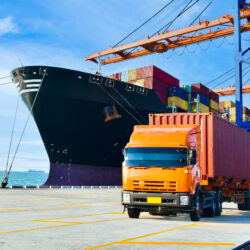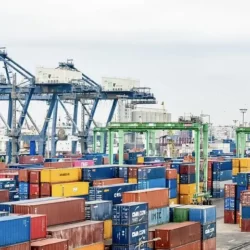Secure Chain improves security when releasing containers imported from Latin America

All containers entering the port of Rotterdam from Latin America will soon be released only through the so-called Secure Chain. This solution puts an end to containers being collected with fraud-sensitive PIN codes. The new way of working creates a closed-loop logistics chain of known, authorized parties only.
Through the Secure Chain, industry and government bodies are making port logistics more digitally resilient together. More secure and more reliable release and collection of containers imported through Dutch ports is an important part of this. Collaboration is the key. Data and cargo move from link to link in the logistics chain, and every transition is a potential risk in this respect. Through the Secure Chain, only known and authorized parties are given access to the necessary information and the ability to perform operations.
No more PIN codes
The Secure Chain – which, incidentally, does not use blockchain technology, unlike at the Port of Antwerp, for example – will come into force from 31 March 2024. This will bring an end to the use of PIN codes. In the old way of working, before collecting a container, the shipping company sent a PIN code to the customer via e-mail. This gave scope for abuse. PIN codes were often widely shared in the logistics chain. Basically, anyone who had the PIN code could go to the terminal to collect the container.
In the Secure Chain, this is a thing of the past. Each link in the chain hands over the right to collect a container to the next designated party. This creates a closed-loop chain of known, authorized parties only. They digitally exchange the necessary information with each other in a secure manner. Operationally, participants also benefit from smart re-use of data and optimal visibility of the status and planning of imported containers throughout the logistics chain.
Implementation via Portbase
The port industry asked Portbase, the neutral logistics platform of the Dutch ports, to make the Secure Chain technically possible. On top of the existing digital services in the Port Community System (PCS), an extra authorization layer has been realized for this purpose. The PCS is already in use by a lot of logistics parties. This keeps the impact of implementing the Secure Chain as small as possible.
For new parties to connect to Portbase for the Secure Chain, a free basic service has been introduced as an extra option. The right to collect a container is thus easily and securely passed on digitally from link to link for everyone. It is estimated that some 8,000 companies are not yet familiar with the PCS. For their participation in the Secure Chain, it is crucial that these parties register with Portbase in time.
Carrier check
Another initiative that the Secure Chain is stimulating is the automatic check of the executing carrier at the container terminal gate. Through this check, terminals can be sure that the driver represents the carrier as announced in the digital pre-notification of the collection via Portbase. The check is done by comparing the EAN number in the pre-notification with the one on the visiting driver’s CargoCard. These EAN numbers are issued by Secure Logistics.
The five major Rotterdam terminal operators – Hutchison Ports ECT Rotterdam, Hutchison Ports Delta II, APM Terminals Maasvlakte II, Rotterdam World Gateway and Rotterdam Shortsea Terminals – see the check on the executing carrier as a logical final step in more secure and more reliable container release and collection through the Secure Chain. At Hutchison Ports ECT Rotterdam, the carrier check is already partially in operation. The other terminals are preparing for its introduction.
Participating shipping companies
CMA CGM, Cosco Shipping, Maersk, MSC, ONE, OOCL and ZIM are the shipping companies operating routes to Rotterdam from Latin America. They are currently connecting their customers step by step. HMM, Yang Ming and Evergreen are also almost there. After containers imported from Latin America, the shipping companies will also gradually introduce the Secure Chain for deep-sea containers from other regions.
To realize the Secure Chain, a large number of parties joined forces. Together, the initiators represent all links in the logistics chain: from the terminal, shipper and forwarder, to the logistics service provider and carrier (road, rail, inland shipping). The Port of Rotterdam Authority, the Municipality of Rotterdam, Dutch Customs, the Seaport Police and several semi-public organizations also support the Secure Chain.







